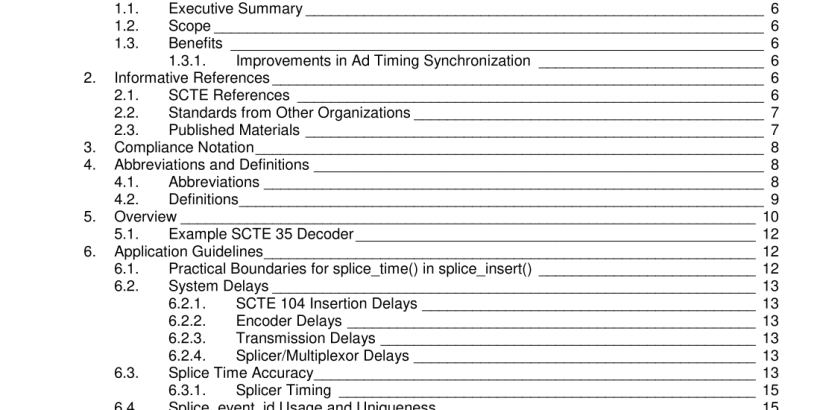ANSI SCTE 67-2017 pdf download.Recommended Practice for Digital Program Insertion for Cable
1.3. Benefits
The purpose of this document is to aid splicing equipment designers, ad insertion equipment designers as well as the purchasers and users of such equipment, such as the networks that will originate Cue Messages from their uplink sites. This document is also expected to aid in the system integration of advertising related equipment, both at the Message origination end and at the Message reception end. SCTE 35 includes content segmentation messages, and this document has been updated to aid the users of these messages. Some of the new devices that will be interpreting the SCTE 35 commands include transcoders, packagers, network PVR and other content manipulation, storage and streaming delivery systems. There may be crucial information within this document for manufacturers of equipment that pass the Cue Message as part of the MPEG-2 transport stream. An example of such equipment is a rate altering re- multiplexer, which performs complex processing of the stream. When the stream is demultiplexed and processed and then re-multiplexed, it is very important to place the Cue Message in the proper position relative to the video service and relative to nearby time-base discontinuities. Such equipment may also be required to alter the Message before retransmission
In Figure 1 [DVS 839], a compliant MPEG-2 transport stream (either Multi Program Transport Stream or Single Program Transport Stream) is assumed for the provider stream. No further constraints beyond the inclusion of the defined Cue Messages are placed upon the stream in SCTE 35. SCTE 35 specifies a technique for carrying notification of upcoming splice points in the transport stream. A splice information table is defined for notifying downstream devices of Splice Events, such as a network Break or return from a network Break. The splice information table, which pertains to a given program, is carried in a separate PID referred to by that program’s Program Map Table (PMT). In this way, Splice Event notification can pass through most transport stream remultiplexers without need for special processing. However, remultiplexers may need to obey certain constraints when they carry the Cue Message. These constraints are addressed in SCTE 35 and are elaborated on within this document. SCTE 35 does not address constraints on splicing devices and SCTE 35 splice_info_table syntax and is not intended to guarantee seamless splicing. By using PTS to reference In Points and Out Points in the program or component streams frame accurate splicing is possible. This document does offer some advice on how to properly encode or condition the video to aid this. While SCTE 35 does not require any stream conditioning, it can be advantageous to get the best splice results. SCTE 172 defines constraints on insertion materials at In Points and Out Points. SCTE 172 also provides suggestions on splicer behavior at In Points and Out Points
5.1. Example SCTE 35 Decoder
A sample java SCTE 35 decoder application written using the Netbeans framework is available (provided separately). It allows you to enter a Base64 or Hex string of the SCTE 35 mpeg section and will decode it with a printout of the data. It will also convert the Base64 or Hex to the opposite format. This is open source sample code and it does not have extensive error checking. It may be useful to understand how to properly parse a Cue Message. The SCTE website will be updated to list the SCTE 35 decoder beside the listing of the SCTE 67.ANSI SCTE 67-2017 pdf download
